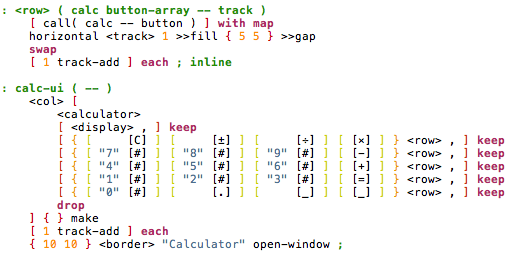Most of the software I work with is very practical. At Oasis Digital we mostly create line-of-business enterprise software, and even when I step away from that, I usually pick up a tool or language that has a good likelihood of mainsteam adoption.

Sometimes, though, I like to really stretch my mind. For that, it’s hard to beat Factor. Factor is fascinating in that it combines a goal of efficiency and practicality, with a syntax and computation model which are quite alien even to a software polyglot. Don’t let the stack-ness deceive you; it’s a big leap even if you’ve used FORTH and grown up with a HP RPN programmable calculator.
So I set about this evening to work with some Factor code, a simple GUI calculator posted a few days ago by John Benediktsson. I bit off an apparently small bit of work: remove the “code smell” of that global variable, and in the process, make it so multiple calcs each have their own model (rather than a global shared state).
The two most important pieces of updated code:

The changes consist approximately of:
- Change all the button words to accept a model input
- Change the <row> word to accept a model and use map instead of output>array
- Remove the calc variable
- Change the calc-ui word to shuffle things around and use make rather than output>array
In case it isn’t obvious from my text above or the source code, I am not a Factor programmer, please do not use this as example code. On the other, I learned a bunch of little things about Factor, and perhaps implicitly about concatenative programming in general, in the process of making this work.

The world would definitely have been better off if we had gone down the FORTH road instead of the Basic road. ;->